
The Pristine Beauty of Russia
/ Главная / Russkiy Mir Foundation / Publications / The Pristine Beauty of RussiaThe Pristine Beauty of Russia
Anna Genova
Russians increasingly prefer to spend their vacations domestically—and not for nothing. After all, you can’t find such a diversity of natural beauty in any other country of our continent. In this selection, we will tell you about some unique corners of Russia that excite the imagination with their grandiose vistas and where rare species of plants and animals are preserved.
The “Chyornye Zemli” State Nature Biosphere Reserve
“Chyornye Zemli” is the only human-made wilderness region in Europe studied by researchers from all over the world. All the diversity of the lands abutting the Caspian Sea is represented in a relatively small territory. You need to coordinate your arrival with the administration, but no other difficulties should be anticipated. You could combine a trip to the reserve with a visit to the republic of Kalmykia, on the territory of which it’s located.
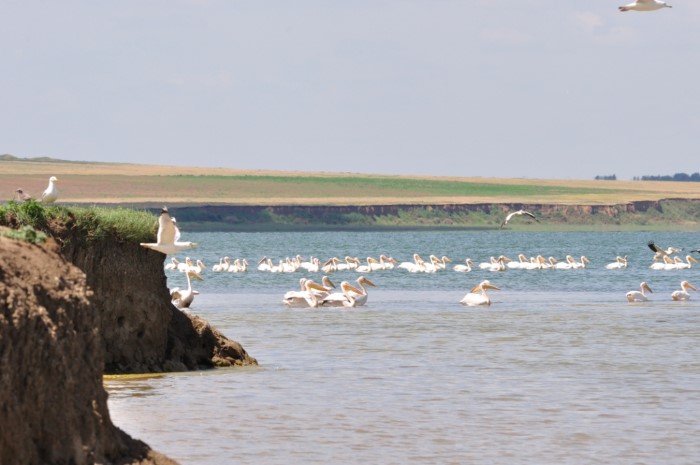
“Chyornye Zemli” Reserve. Photo: Iu. Bykov / zapovednik-chernyezemli.ru
Characteristic representatives of the “Chyornye Zemli” flora are wormwood, needle grass, camelthorn, lyme grass, chrysanthemum, glasswort—in all, 291 species sprout in this region, out of which 13 plant species are under protection: Taliev’s cornflower, Schrenk’s tulip, dwarf and coriaceous irises, and others. The wandering parmelia, a variety of lichen, has long been used in traditional Kalmyk medicine as an anti-inflammatory, blood-stanching, and bactericidal remedy.
The local fauna is incredibly abundant. This reserve’s symbol is one of its most preserved residents: the saiga antelope. In addition, one can wonder at such little-known animals as the bobak marmot, the corsac fox, the African wildcat, toad-headed agama, and the white-breasted hedgehog.
Lake Manych-Gudilo is a source of undeniable interest. The water of this huge lake is twice as salty as the Black Sea! Here are located the nests and hibernation lairs of many rare species of water and semi-aquatic fowls. There are several islands on the lake, the largest of which are Watery and Bird Islands. The name of the latter speaks for itself: rare avian species gather here every year. Lovers of ornithology will be ecstatic when they see a little white heron, spoonbill, mute swan, Caspian gull, Dalmatian and great white pelicans, and others. Bird Island is recognized as an important ornithological territory of international significance. Here there is also a little island, which is smaller but unbelievably beautiful: Tulip Island. Of course, you can only admire the flowers once a year for several weeks in the spring, so before you go, you must certainly find out the exact dates.
An oasis in the Eastern Sayan Mountains, it was built (uniquely in Russia) on the initiative of local residents in order to preserve its priceless nature. One of the most popular and accessible nature reserves for tourists, it is located a half-hour’s journey from Krasnoyarsk.
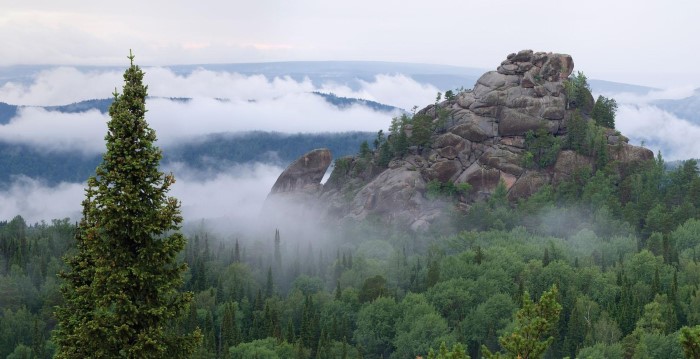
Stolby Nature Sanctuary. Photo: zapovednik-stolby.ru
The “Stolby” [Columns] are essentially gigantic syenitic cliffs with a complex structure of walks and climbs. From a distance they resemble profiles of people, animals, or mythical beings. “Old Man,” “Woman,” “Feathers,” “Little Elephant”—such are the nicknames for the cliffs thought up by locals. Does one even need to mention that both children and adults will be thrilled not only by the beautiful sights, but also by the local residents’ sense of humor? Rock climbing is regarded as the province of professionals or trained amateurs, but everyone walks to the Krasnoyarsk Stolby. Here you might encounter a family with a little child or elderly retirees. If anything comes up, novices will find help, advice, and company.
According to studies, the history of Stolby began about 50 million years ago, but these stone sculptures were first mentioned in written documents at the beginning of the 18th century. The first to appreciate the beauty of these unusual cliffs were hunters. They called the sculptures columns [stolpy] to emphasize the grandiose beauty of these natural creations. In the 19th century, the era of “column-ism” began when a group of wards from the lodge under the direction of Veniamin Kalin made an ascent onto the first of these columns. This was one of the biggest sporting achievements of the time.
In order to reach the cliffs, one must walk 2 km to the park entrance, where one will receive instructions, and then go another 5 km to the first column. For many, the trip—or at least, the first one—can just end here. The more resolute can go further to master the mountains.
Besides the columns themselves, the flora and fauna of this natural park certainly deserve attention. One can see 150 plant species marked in the Red List at the nature reserve. Among them are true and large-flowered Wolfsbane, marsh orchid, and relics of the Ice Age: viola biflora, spring minuartia, snow cinquefoil, geranium albiflorum, and Siberian patrinia. Lovers of coniferous varieties will see the majority of them—and of course, enjoy the curative air. For bird lovers, among the 199 species in the reserve there is the chance to photograph several from the Red List, including the long-tailed rosefinch, the steppe eagle, imperial eagle, fish hawk, and others.
At the present moment Altai is one of the most visited tourist areas on Russian territory. It is popular among both Russian and international tourists. The territory preserved by UNESCO includes the Altai and Katun Nature Reserves, a three-mile preservation zone around Lake Teletskoye, the Belukha nature park, and the Ukok Plateau tranquil zone.
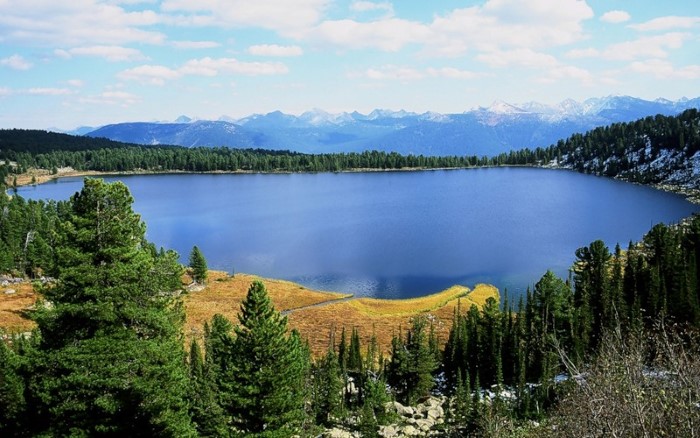
Altai. Photo: altzapovdnik.ru
A significant part of the Altai reserve is located at the meeting point of the Altai and Sayan mountain systems. Here you will find Siberian taiga, lakes, steppe, tundra, and grassland meadows.
One of the main sights to see is Lake Teletskoye, the right bank of which is located on the territory of the reserve, along with 22,000 hexameters of its water surface. In the summer, one can observe on the banks the most beautiful waterfalls, including the large Korbu waterfall (open to visitors).
The local flora represents a treasure trove: the lichens and seaweeds alone number more than 500 varieties, and there are 1480 plant species. Many of them number in the Red List. The forests cover nearly half the overall territory. The mountain cedar forests are the pride of the reserve.
The most wide-ranging species of fauna are sable and elk, as well as musk deer, wild bore, moose, roe, snow leopard, an Altai mountain ram called argali. As for predators, you can encounter a brown bear, wolf, panther, or wolverine. The territory hosts 59 rare and disappearing animal species. Among the 326 species of birds, you can see wood grouse, hazel grouse, ptarmigan, and even rarer species: the golden eagle and the black stork.
The diversity of plant and animal life, enormous territory, and incredible beauty of the landscape make it undoubtedly worthwhile to come here at least once in one’s life. The reserve can be visited by people at any age, with various interests, but it’s important to reserve at least a couple weeks.
Baikal State Biosphere Nature Reserve
This nature reserve zone preserved by UNESCO is located in southern Buryatia. The reserve occupies a central portion of the Chamar-Daban mountain range and stretches along the southern bank of Lake Baikal.
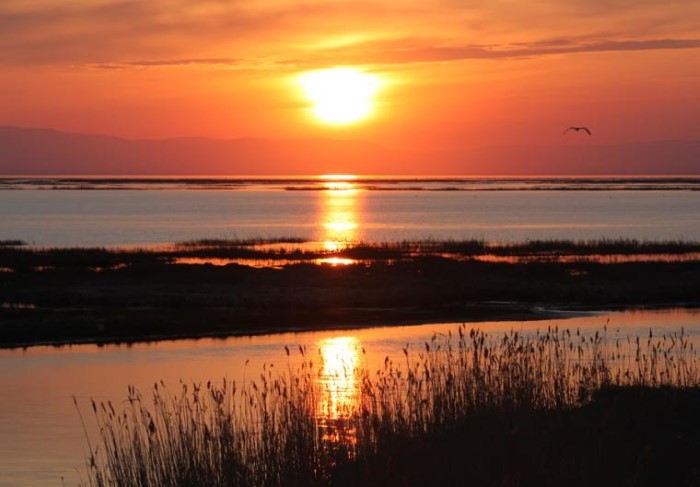
Caption: Selengi Delta (Kaban Sanctuary in Baikal Reserve). Photo: A. Vtorushin / baikal-zapovednik.ru
This reserve might be of interest for family trips, since, in addition to the incredible views of the Mongolian steppes and the eastern Siberian taiga, it also has biological stations adapted for young ecologists. In the Nature Museum you will be taught to distinguish the voices of birds and beasts, and in the Ethno-City you can view traditional Siberian dwellings. What’s more, in the environs of the town Tankhoi there are operating tour routes for all groups of visitors, including for people with restricted abilities. There is also a pathway with a wooden pathway more than 2 km long, going through various natural complexes and featuring a view of the Chamar-Daban mountain range.
The flora of this reserve represents various types of forest, swamp, and meadow. On the northern slopes of the Chamar-Daban mountain range, one can delight one’s eyes and inhale the scent of cedars and silver firs. Higher up, there are subalpine and alpine meadows, and on the southern slope there are primarily pine and larch forests. It is paradise for mushroom hunters.Botanists at the reserve open the season in the spring by studying around 900 species of vascular plants. Besides the Baikal itself, about which legends have been written, on the territory of the reserve there are many very pure mountain rivers and lakes.
Overall, fauna are typical for the mountains of South Siberia. If you are lucky, you will meet such rare birds as the black stork, whooping swan, and the largest snipe among Russian fauna—the large curlew. Some of the animals you can easily encounter in this region are the brown bear and that powerful beauty, the East Asiatic red deer.
Kronotsky Nature Reserve (Kamchatka)
Just the word Kamchatka already sounds enchanting. It’s a long and expensive journey to get out there, but if you’ve resolved to go on such a journey, one of the very best places to visit is the Kronotsky Nature Reserve. This is one of the most famous nature reserves in Kamchatka. It is located in the eastern part of the peninsula.
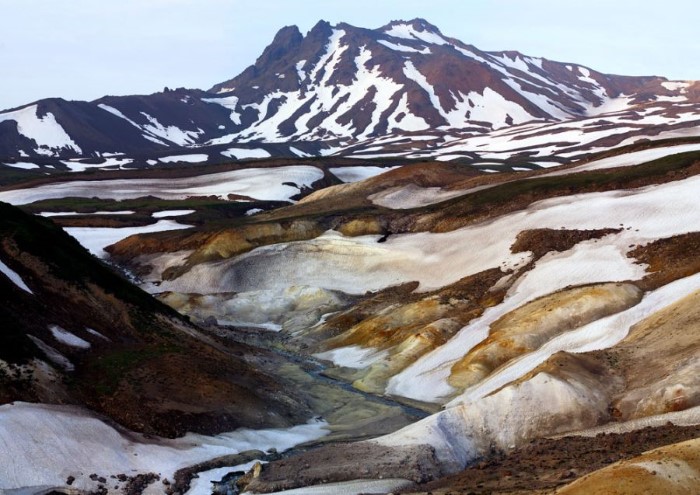
Valley of Death. Photo: I. Shpilenok / kronoki.ru
A great number of bird and fish species roam here. The white-tailed and white-shouldered sea eagles and golden eagles (which feed on salmon) especially make an impression. The most characteristic inhabitant of these locales is the brown bear: there are about 800 of them on the territory. The reserve directors lead tours, and several of them are purposefully devoted to bears. In August and September, for instance, one can watch bears catch fish—without nets, snatching their prey from the water in mere seconds. In this area you can also meet squirrels, lynxes, minks, muskrats, and moose. And during seafaring excursions, one can see sea lions and whales.
The flora is characterized by a great variety of types. Here there are abundant coniferous forests. The larch forest and grove of Sakhalin fir deserve special attention; silver-fir groves and untouched fir forests also tower here.
And of course, we shouldn’t forget that Kamchatka is a land of volcanoes. On tours, one can admire active volcanoes, thermal lakes and waterfalls, and the Chazhmin and Tiushev hot springs. Sites you must see include the Valley of Death, where beasts and birds die suddenly, the renowned Valley of the Geysers, and the already mentioned Kronotsky Lake—the largest freshwater reservoir in Kamchatka, in a shape resembling an equilateral triangle. You must also see the beautiful glaciers and the caldera of the Uzon volcano.
Putorana Plateau
Located in northern East Siberia in the subarctic belt zone, at the border of the taiga and the tundra, this basalt plateau is practically untouched by civilization. The Putorana Plateau is renowned for its fantastic scenic views, gigantic tectonic lakes, and waterfalls.
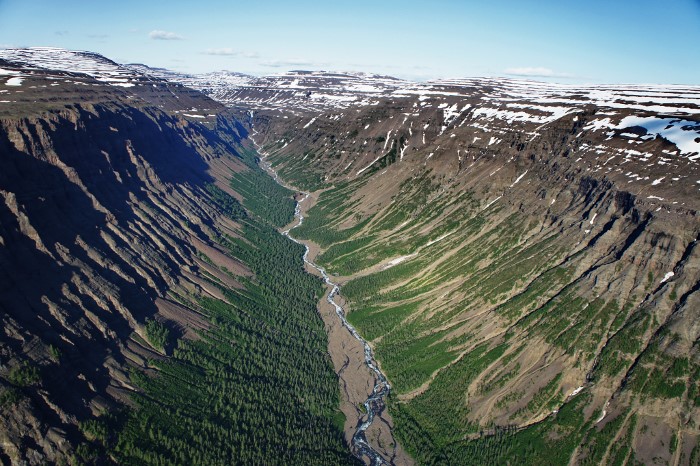
Caption: Putorana Plateau. Photo: ag24.ru
If you are after acute impressions that you can not only brag about later, but also remember for your whole life, the Putorana Plateau is precisely the place that will produce such an impression on any traveler, even the most experienced. You must travel there with a group of like-minded people by taking a flight from Norilsk, Krasnoyarsk, or Svetlogorsk. You shouldn’t forget about the importance of proper equipment in this severe region.
The distinguishing feature of this place is, without a doubt, the unforgettable beauty of nature there. If one were to add together the volumes of all the Putorana lakes—which number more than 25 thousand—they would form the second most voluminous freshwater reservoir in Russia, after Lake Baikal. One of the most beautiful, as well as one of the most accessible Putorana lakes is Lake Lama, which forms a colossal canyon in the eastern region.
The plateau has the greatest concentration of waterfalls on Russian territory. The tallest is the 108-meter Talnikovy Waterfall on the Kanda River. Professionals and amateurs fly in from many parts of the world to photograph this wonder.
Despite being located in the Northern Polar Circle, this plateau is home to many animals and birds: wolves, wolverines, lynxes, sables, bears, and even a little-studied population of snow sheep marked down in the Red List. The distinguishing feature of the animal world in this plateau is the seasonal migration of the largest Taimyr population of wild northern deer in Eurasia.
This land is also interesting to those who love fishing and spearfishing. There exist organized escorted tours, which include floating on the rivers and fishing, with flights departing from Krasnoyarsk in Turukhansk.
One of the largest mountain forest reserves in Europe and the oldest reserve in Russia, it is interesting from every point of view and for all categories of visitors. It will provide interesting occupations for both those who enjoy hikes and unprepared tourists, even families with little children—it all depends on the trail you pick.
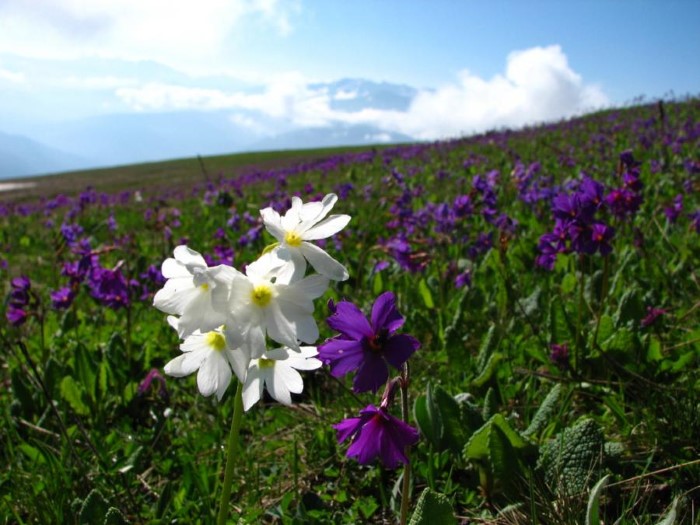
Caption: Anemone. Photo: kgpbz.ru
For lovers of fauna there is a great variety here: hedgehogs, moles, squirrels, and various families of cats, raccoons, pigs, and deer are represented in all their diversity. Turning to large mammals, in the reserve you can see bison, brown bear, Caucasian tur, chamois, lynx, roe, and wild boar. Many animals in the reserve are contained in the Red List. The nature in this land is varied enough to guarantee the possibility for coexistence among all of our little brothers, the majority of which don’t even have a suspicion (to their good fortune) of homo sapiens. To take a closer look at the animal world of this reserve, travel to the Volerny Complex for wild animals in the Laura protected cordon, not far from Krasnaya Polyana.
Even the most experienced lovers of natural beauty will find much that is new to them: the reserve’s flora boasts 3000 species, including many flowers.
The Caucasus Reserve is also known for its lakes. One can’t really expect to see all 120 lakes in a single visit, but it’s certainly worth visiting the largest one: the glacial lake called “Silence,” the area of which comprises 200 thousand square meters. Generally, the lakes there are not very large, and many of them are covered in ice even at the beginning of the summer.
Separate from the primary territory, not far from Sochi, the world-renowned Yew and Boxwood Grove is located, which is famous for the Colchian forest. Your imagination will be stirred by the 30-meter yew trees of ages up to two thousand years! In this same place there grow more than 400 species of rare plants from before the Ice Age, among them tropical mushrooms and orchids.
For those traveling with children, it is recommended to visit the ropes course amusement park on the Guzerpil cordon in the northern part of the reserve. A small town of the same name, located on the grounds of the park, features all necessary hotel services. It is located in the south of the Adygea republic in the foothills of the Caucasus Mountains, near the Belaya River. Besides the natural sights and crystal clear air, the ropes park offers interesting trails with various levels of difficulty, so it will be interesting for the whole family.
New publications

 Mikhail Kalatozov, a director who transformed the world of cinematography in many ways, was born 120 years ago. He was a Soviet film official and a propagandist. Above all, he was capable of producing movies that struck viewers with their power and poetic language.
Mikhail Kalatozov, a director who transformed the world of cinematography in many ways, was born 120 years ago. He was a Soviet film official and a propagandist. Above all, he was capable of producing movies that struck viewers with their power and poetic language.  Ukrainian authorities have launched a persecution campaign against the canonical Ukrainian Orthodox Church (UOC), the biggest one in the country's modern history. Over the past year, state sanctions were imposed on clergy representatives, searches were conducted in churches, clergymen were arrested, criminal cases were initiated, the activity of the UOC was banned in various regions of the country, and monasteries and churches were seized.
Ukrainian authorities have launched a persecution campaign against the canonical Ukrainian Orthodox Church (UOC), the biggest one in the country's modern history. Over the past year, state sanctions were imposed on clergy representatives, searches were conducted in churches, clergymen were arrested, criminal cases were initiated, the activity of the UOC was banned in various regions of the country, and monasteries and churches were seized.  When Nektary Kotlyaroff, a fourth-generation Russian Australian and founder of the Russian Orthodox Choir in Sydney, first visited Russia, the first person he spoke to was a cab driver at the airport. Having heard that Nektariy's ancestors left Russia more than 100 years ago, the driver was astonished, "How come you haven't forgotten the Russian language?" Nektary Kotlyaroff repeated his answer in an interview with the Russkiy Mir. His affinity to the Orthodox Church (many of his ancestors and relatives were priests) and the traditions of a large Russian family brought from Russia helped him to preserve the Russian language.
When Nektary Kotlyaroff, a fourth-generation Russian Australian and founder of the Russian Orthodox Choir in Sydney, first visited Russia, the first person he spoke to was a cab driver at the airport. Having heard that Nektariy's ancestors left Russia more than 100 years ago, the driver was astonished, "How come you haven't forgotten the Russian language?" Nektary Kotlyaroff repeated his answer in an interview with the Russkiy Mir. His affinity to the Orthodox Church (many of his ancestors and relatives were priests) and the traditions of a large Russian family brought from Russia helped him to preserve the Russian language.

 The leaders of the Friends of the Great Russia cultural association (Amici Della Grande Russia) in Italy believe that the Western policy of abolishing Russian culture in Europe has finally failed. Furthermore, it was doomed to failure from the beginning.
The leaders of the Friends of the Great Russia cultural association (Amici Della Grande Russia) in Italy believe that the Western policy of abolishing Russian culture in Europe has finally failed. Furthermore, it was doomed to failure from the beginning.  Name of Vladimir Nemirovich-Danchenko is inscribed in the history of Russian theater along with Konstantin Stanislavski, the other founding father of the Moscow Art Theater. Nevertheless, Mr. Nemirovich-Danchenko was a renowned writer, playwright, and theater teacher even before their famous meeting in the Slavic Bazaar restaurant. Furthermore, it was Mr. Nemirovich-Danchenko who came up with the idea of establishing a new "people's" theater believing that the theater could become a "department of public education."
Name of Vladimir Nemirovich-Danchenko is inscribed in the history of Russian theater along with Konstantin Stanislavski, the other founding father of the Moscow Art Theater. Nevertheless, Mr. Nemirovich-Danchenko was a renowned writer, playwright, and theater teacher even before their famous meeting in the Slavic Bazaar restaurant. Furthermore, it was Mr. Nemirovich-Danchenko who came up with the idea of establishing a new "people's" theater believing that the theater could become a "department of public education."  "Russia is a thing of which the intellect cannot conceive..." by Fyodor Tyutchev are famous among Russians at least. December marks the 220th anniversary of the poet's birth. Yet, he never considered poetry to be his life's mission and was preoccupied with matters of a global scale. Mr.Tyutchev fought his war focusing on relations between Russia and the West, the origins of mutual misunderstanding, and the origins of Russophobia. When you read his works today, it feels as though he saw things coming in a crystal ball...
"Russia is a thing of which the intellect cannot conceive..." by Fyodor Tyutchev are famous among Russians at least. December marks the 220th anniversary of the poet's birth. Yet, he never considered poetry to be his life's mission and was preoccupied with matters of a global scale. Mr.Tyutchev fought his war focusing on relations between Russia and the West, the origins of mutual misunderstanding, and the origins of Russophobia. When you read his works today, it feels as though he saw things coming in a crystal ball...